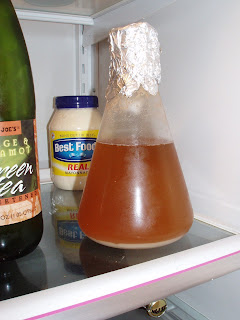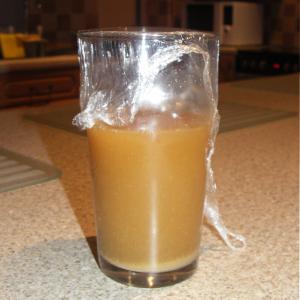Last evening I got my yeast starter going for this weekends brew (Imperial Black IPA). I poured 600 mL of water, two tablespoons of my LME, and two Chinook cones into my 1000 mL Erlenmeyer flask. Since I only have an electric stove, I placed the flask into my brew pot and pour additional water around it creating an emersion bath to bring the contents of the flask to a boil. I then allowed the flask to cool to 75 degrees ferinheight and added my White Labs California yeast. I went with the advice of my local brew store and placed the airlock that I normally use for my fermenters on top of the flask and did not / have not seen much activity. All the yeast have settled on the bottom of the flask as of this morning. I am concerned after reading numerous threads about the importance of the yeast having access to oxygen in their growing period. Can anyone give me their two 1/100th of a dollar on the issue of airlocks in yeast starters?
You are using an out of date browser. It may not display this or other websites correctly.
You should upgrade or use an alternative browser.
You should upgrade or use an alternative browser.
Airlocks & Yeast Starters
- Thread starter bmbissell
- Start date

Help Support Homebrew Talk:
This site may earn a commission from merchant affiliate
links, including eBay, Amazon, and others.
An airlock is not a fermentation gauge, it's a vent. Whether it bubbles or not really doesn't mean anything and shouldn't be a source of worry.
In terms of starters we've over the last few years found that sanitized foil works better than an airlock on starters anyway.
Activity in a starter really only means one thing and one thing only.
It doesn't matter one blip in your fermenter or your starter flask if the airlock bubbles or not (if you are using an airlock and not tinfoil if you are using tinfoil, you aren't getting bubbling anyway,) or if you see a krauzen.
In fact starter fermentation are some of the fastest or slowest but most importantly, the most boring fermentations out there. Usually it's done withing a few hours of yeast pitch...usually overnight when we are sleeping, and the starter looks like nothing ever happened...except for the little band at the bottom. Or it can take awhile...but either way there's often no "activity" whatsoever....
I usually run my stirplate for the first 24 hours, then shut it down, if you are spinning your starter it is really hard to get a krausen to form anyway, since it's all spinning, and there's often a head of foam on it from the movement.
All that really matters is that creamy band o yeast at the bottom.

This is a chilled sample so it's flocculated, but even with an unchilled sample you should see a band of yeast at the bottom. Here's an unchilled version

Same thing, a band.
As it is I've only ever seen two or three krausens actually on my starter (one blew off a bunch of krausen and knocked the tinfoil off the flask,) and the evidence of one on the flask at the "waterline" once. But I've never not had a starter take off.
Look for the yeast at the bottom, don't worry what it looks like on top.
If you have yeast on the bottom....that's all you really need.
If it looks anything like that, your are ready to either feed it again, or use it.
In terms of starters we've over the last few years found that sanitized foil works better than an airlock on starters anyway.
Activity in a starter really only means one thing and one thing only.
It doesn't matter one blip in your fermenter or your starter flask if the airlock bubbles or not (if you are using an airlock and not tinfoil if you are using tinfoil, you aren't getting bubbling anyway,) or if you see a krauzen.
In fact starter fermentation are some of the fastest or slowest but most importantly, the most boring fermentations out there. Usually it's done withing a few hours of yeast pitch...usually overnight when we are sleeping, and the starter looks like nothing ever happened...except for the little band at the bottom. Or it can take awhile...but either way there's often no "activity" whatsoever....
I usually run my stirplate for the first 24 hours, then shut it down, if you are spinning your starter it is really hard to get a krausen to form anyway, since it's all spinning, and there's often a head of foam on it from the movement.
All that really matters is that creamy band o yeast at the bottom.

This is a chilled sample so it's flocculated, but even with an unchilled sample you should see a band of yeast at the bottom. Here's an unchilled version

Same thing, a band.
As it is I've only ever seen two or three krausens actually on my starter (one blew off a bunch of krausen and knocked the tinfoil off the flask,) and the evidence of one on the flask at the "waterline" once. But I've never not had a starter take off.
Look for the yeast at the bottom, don't worry what it looks like on top.
If you have yeast on the bottom....that's all you really need.
If it looks anything like that, your are ready to either feed it again, or use it.
Similar threads
- Replies
- 149
- Views
- 15K

